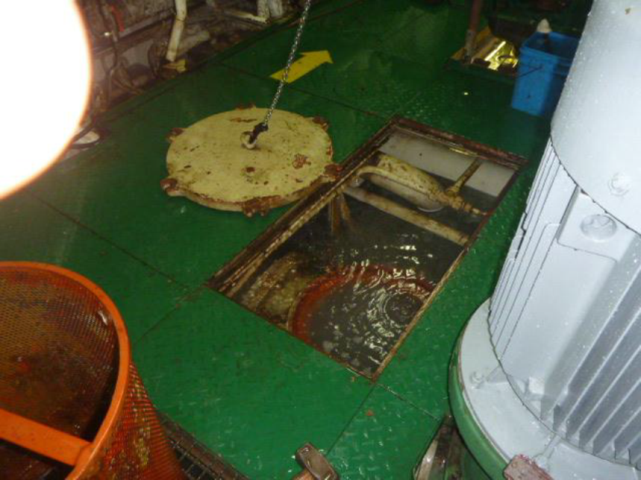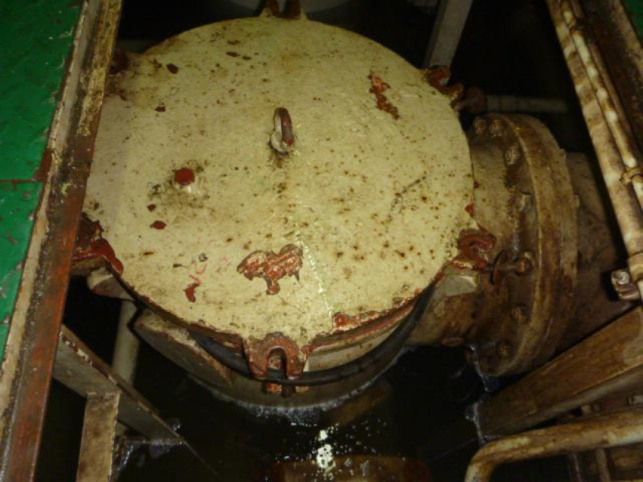Near-miss: Engine room flooding
A member has reported an incident in which the engine room of a seagoing vessel was flooded to a level of two metres above tank top (to just below the engine room floor plating). Had the flooding incident lasted a few minutes longer, serious machinery damage could have been the result. The incident occurred during ballasting operations, when the configuration of pumping from and to ballast tanks was altered. During this process the cover plate of the sea strainer was blown off. This resulted in seawater ingress into the engine room. Engine room personnel instructed the bridge officer in charge of ballasting to stop ballasting operations (without mentioning reasons). As per company procedure, the overboard suction valve and overboard discharge valve were opened to ‘de-energize’ the pumping system. This worsened the situation since a direct connection between open water and engine room was created. This was noticed by engine room personnel immediately and the bridge officer was instructed to close overboard valves. There was no damage and no injuries.


Our member’s investigation revealed the following:
- Root cause: malfunctioning of one of the actuators of the valves in the ballast pipelines caused the valve to close in 1.5-2 seconds (normally 15-20 seconds). This created a pressure shock in the ballast system. Subsequently, this pressure shock caused the cover plate of the sea strainer to blow off;
- The actuator of the valve which was closing in 1.5-2 seconds was replaced by vessel crew in early 2014 without verification of the opening/closing time of the valve;
- Root cause: communication between engine room personnel and bridge personnel was not sufficiently detailed; this resulted in incorrect actions being taken which caused a worsening of the situation;
- Root cause: ballasting procedure of manufacturer was not followed. The recommended procedure described that pump(s) should be stopped before operating valves in the ballast lines. This was not followed.
Our member learnt the following lessons:
- Introduced vessel-specific procedures for ballasting and added this instruction to the official document list of vessel;
- Following the hierarchy of control, the company recognised it could not eliminate nor substitute the ballast process on board. Therefore, it focused on the following engineering controls by:
- improving visual presentation for valve operations on the bridge to emphasize valve position and open lines in the ballast system
- introduction of interlock system to eliminate simultaneous operations of valve(s) and pump(s).
Members may wish to refer to the following similar incidents (key words: engine, room, and flood):
Safety Event
Published: 3 October 2014
Download: IMCA SF 16/14
IMCA Safety Flashes
Submit a Report
IMCA Safety Flashes summarise key safety matters and incidents, allowing lessons to be more easily learnt for the benefit of all. The effectiveness of the IMCA Safety Flash system depends on Members sharing information and so avoiding repeat incidents. Please consider adding safetyreports@imca-int.com to your internal distribution list for safety alerts or manually submitting information on incidents you consider may be relevant. All information is anonymised or sanitised, as appropriate.
IMCA’s store terms and conditions (https://www.imca-int.com/legal-notices/terms/) apply to all downloads from IMCA’s website, including this document.
IMCA makes every effort to ensure the accuracy and reliability of the data contained in the documents it publishes, but IMCA shall not be liable for any guidance and/or recommendation and/or statement herein contained. The information contained in this document does not fulfil or replace any individual’s or Member's legal, regulatory or other duties or obligations in respect of their operations. Individuals and Members remain solely responsible for the safe, lawful and proper conduct of their operations.
